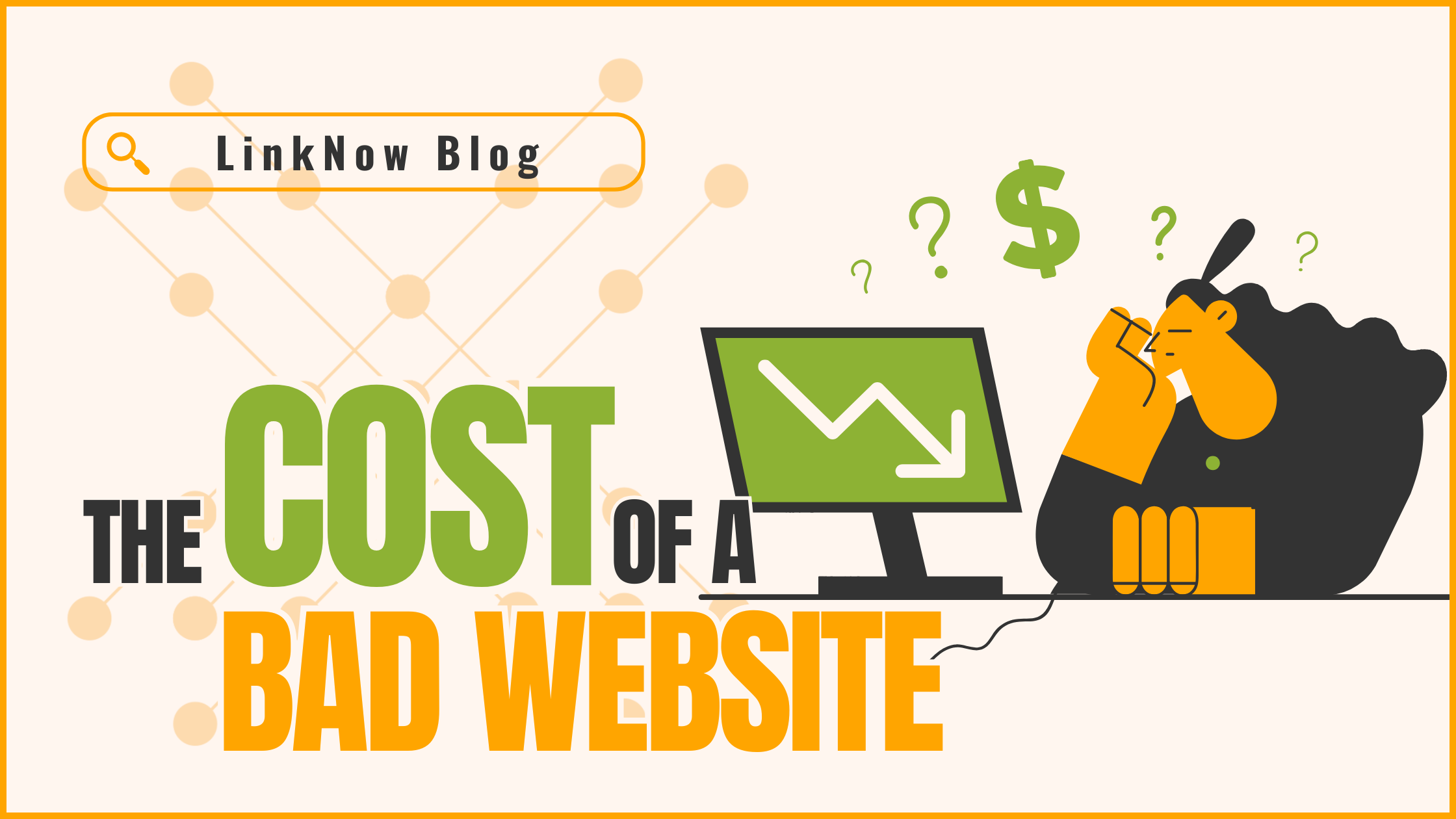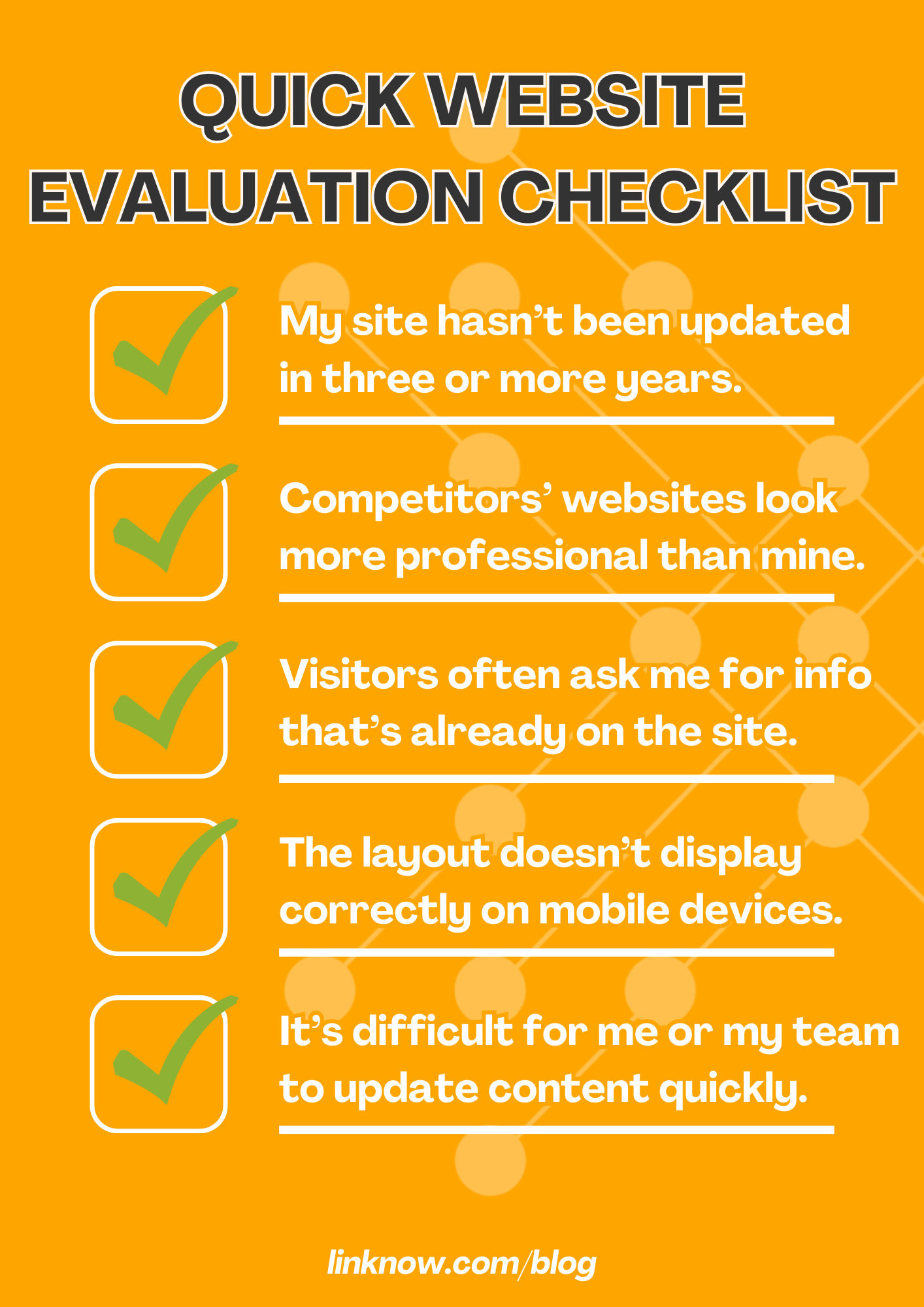
Overview
Outdated web design costs more than you think. In this LinkNow blog, we explore how poor credibility, bad navigation, and missing features may be driving your customers away.
Highlights
- • How Poor Website Design Impacts Credibility
- • The Hidden Costs of Bad Navigation
- • What Are the Must-Have Website Features for 2026?
- • The Long-Term ROI of a Modern Website
- • How Can You Tell If Your Website Needs a Redesign?
Introduction
Your website is often the very first interaction a customer has with your business. In today’s online-driven marketplace, that first impression can make or break a sale. Studies show users form opinions about a brand’s credibility in a fraction of a second, meaning design, navigation, and usability carry more weight than most business owners realize.
This blog explores how poor design impacts your credibility, the hidden costs of bad navigation, and the must-have features every site needs to be competitive. If you’ve ever wondered whether your website is helping your business or hurting it, you’re about to find out.

How Poor Website Design Impacts Credibility
When someone lands on your website, you don’t get much time to win them over. Research shows that users form an opinion about a business’s credibility in as little as 50 milliseconds. In other words, your site's colors, layout, and overall design instantly set the tone for whether a visitor trusts you or hits the back button.
First Impressions Matter
Imagine walking into a store where the lights flicker, the signage is faded, and the shelves are disorganized. Even if the products are great, you’d probably second-guess whether you wanted to buy anything. The same principle applies online. An outdated design makes visitors question the professionalism of the business behind it.
Trust Signals and Professionalism
According to the Edelman Trust Barometer, 81% of people say they need to trust a brand before making a purchase. A sleek, modern website communicates care, attention to detail, and reliability. On the other hand, a clunky, old-fashioned layout can give the impression that the company doesn’t keep up with the times, or worse, that the site could be unsafe.
A Real-World Comparison
Picture two websites side by side:
- • Site A looks like it hasn’t been updated since 2005. It has small, hard-to-read fonts, grainy images, and a “Contact Us” page buried behind multiple other pages.
- • Site B features clean visuals, high-quality images, easy navigation, and a clear call-to-action right on the homepage.
Which site would you trust with your personal information or credit card details? The answer is obvious, and it’s the same answer that potential customers are giving every time they visit a poorly designed site.
The Hidden Costs of Bad Navigation
Even the most visually appealing website will fail if visitors can’t easily find what they’re looking for. Clear navigation can be directly linked to sales, customer satisfaction, and even search rankings.
Lost Sales Opportunities
When menus are cluttered, labels are vague, or important information is buried, potential customers simply leave. According to an often-cited Forrester study, 50% of potential sales are lost because users can’t find information quickly. That means a confusing layout directly costs businesses revenue.

User Frustration
Customers expect an intuitive design. If a visitor has to click through multiple menus or guess which button leads to what they need, frustration builds. In today’s world of endless online choices, most users won’t stick around to figure things out—they’ll go straight to a competitor’s site that makes things easier.
SEO Implications
Navigation also plays a major role in how Google evaluates your site. High bounce rates and short session times are red flags that signal poor user experience. Over time, this can push your site lower in search results, reducing visibility and making it even harder for customers to find you in the first place.
A Costly Misconception
Many small businesses hesitate to invest in a redesign because they see it as an expense. In reality, the real expense is keeping a poorly structured site online. Every day that customers abandon your site in frustration is a day of lost leads, missed opportunities, and hidden costs that quietly add up.
What Are the Must-Have Website Features for 2026?
A strong online presence requires more than just attractive visuals. In 2025, customers expect websites to work seamlessly, feel intuitive, and reflect current digital standards, all trends that are likely to continue into the next year.
If your site is missing the following essentials, you may be turning visitors away before they ever become customers.
Mobile-First Design
With over 60% of global web traffic now coming from mobile devices, your site must be built with smartphones in mind. That means responsive layouts, easy-to-tap buttons, and content that looks great on smaller screens. Businesses that ignore mobile optimization risk alienating more than half of their audience.
Clear Calls-to-Action
Visitors should never wonder what to do next. Whether it’s booking an appointment, filling out a form, or calling your office, strong CTAs guide people toward action. Prominent buttons, simple forms, and strategically placed links make the difference between someone only browsing your site and someone becoming a paying customer.
Visual Storytelling
High-quality visuals communicate more than words ever could. Professional photography, short videos, and clean graphics give your brand personality and credibility. A well-placed explainer video or icon-based service section captures attention while also helping visitors quickly understand what you offer.
Accessibility for All
Digital accessibility is now an important part of keeping your website user-friendly, and is also legally required in many cases. Making your site ADA-compliant ensures people with disabilities can navigate it with ease. Features like alt text, proper color contrast, and keyboard-friendly design broaden your audience while also boosting your SEO performance.
Security Signals
Trust is everything online. A visible HTTPS certificate, along with trust badges, privacy policies, and secure payment options, reassures visitors that their information is safe. Without these signals, even interested customers may hesitate to hand over personal or financial details.
Integration With Customer Tools
Modern websites should be seen as interactive hubs rather than informational brochures. Adding tools like contact forms, online scheduling, or digital payment systems makes your site work harder for your business. Customers increasingly expect this convenience, and offering it can set you apart from competitors.
The Long-Term ROI of a Modern Website
Redesigning or upgrading your website is an investment that pays dividends over time. A modern site attracts attention and works behind the scenes to increase leads, strengthen customer relationships, and outpace competitors.
Conversion Boost
A professional, user-friendly design can dramatically improve conversion rates. Forbes reports that businesses focusing on design and user experience see up to a 200% increase in conversion rates compared to outdated sites. Clear navigation, streamlined forms, and strong calls-to-action help transform casual browsers into loyal customers.
Customer Retention
Winning a customer is only half the battle—keeping them is where the real ROI lies. Easy-to-use websites encourage repeat visits by making information simple to find and actions effortless to complete. When customers know they can always rely on your site for a smooth experience, they’re more likely to come back instead of searching elsewhere.
Competitive Edge
In crowded markets, a well-designed website can be the deciding factor. Businesses that invest in modern design and functionality stand out, gain credibility, and often capture the market share competitors leave behind. According to McKinsey & Company, companies that prioritize design outperform those that don’t by a wide margin in customer loyalty and revenue growth.
How Can You Tell if Your Website Needs a Redesign?

Sometimes business owners know their site isn’t working, but they can’t pinpoint exactly why. If you’re unsure whether your website is helping or hurting your business, here are a few key questions to ask:
- • Does your site look older than your competition? If your competitors’ websites look fresh, modern, and polished while yours feels stuck in the past, customers may assume their businesses are more professional or trustworthy.
- • Can customers find information in three clicks or fewer? A user-friendly site makes important details (like your services, pricing, and contact options) easy to find. If customers need to dig through menus or guess where to click, frustration leads them elsewhere.
- • Is your site compatible with current devices and browsers? A modern website should display correctly on desktops, tablets, and smartphones. If parts of your site break, stretch, or load improperly on certain devices, it’s a clear signal you’re due for an update.
Don’t Let an Outdated Site Hold Your Business Back
From lost sales opportunities to reduced search visibility, a neglected design costs more than a redesign ever will. Modern websites build trust, convert visitors into customers, and give you an edge over competitors who fail to keep up.
The question isn’t if your business can afford to redesign. The real question is: How much longer can you afford not to?
Ready to turn your website into a growth engine? Schedule a professional website audit today and discover how an updated design can win you more customers, more trust, and more revenue.

